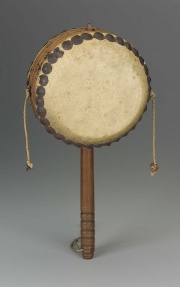Difference between revisions of "Pigskin"
Jump to navigation
Jump to search
m (Text replace - "\[http:\/\/cameo\.mfa\.org\/materials\/fullrecord\.asp\?name=([^\s]+)\s(.*)\]" to "$2") |
|||
| (One intermediate revision by the same user not shown) | |||
| Line 1: | Line 1: | ||
| − | [[File:17.2120-SC24676.jpg|thumb| | + | [[File:17.2120-SC24676.jpg|thumb|Chinese drum<br>MFA Acc. #: 17.2120]] |
== Description == | == Description == | ||
A leather produced from the skin of a domestic pig, ''Sus scrofa''. Pigskin has a characteristic nobby grain pattern produced by the hair follicles which are arrange in roughly triangular groups of three. These holes pass through the leather and are caused by pulling the bristles out of the skin. Pigskin is a tough and durable leather. It is used to make bags, shoes, gloves, luggage, and footballs. | A leather produced from the skin of a domestic pig, ''Sus scrofa''. Pigskin has a characteristic nobby grain pattern produced by the hair follicles which are arrange in roughly triangular groups of three. These holes pass through the leather and are caused by pulling the bristles out of the skin. Pigskin is a tough and durable leather. It is used to make bags, shoes, gloves, luggage, and footballs. | ||
| − | See also [[ | + | See also [[Peccary leather|peccary]] and [[capybara|capybara]]. |
| + | [[File:Sowandpiglets.jpg|thumb|Sow and piglets]] | ||
== Synonyms and Related Terms == | == Synonyms and Related Terms == | ||
| Line 10: | Line 11: | ||
hogskin; piel de cerdo (Esp.); cuir de porc (Fr.); pele de porco (Port.) | hogskin; piel de cerdo (Esp.); cuir de porc (Fr.); pele de porco (Port.) | ||
| − | |||
| − | + | == Resources and Citations == | |
| − | |||
| − | |||
| − | |||
| − | |||
| − | == | ||
* Matt Roberts, Don Etherington, ''Bookbinding and the Conservation of Books: a Dictionary of Descriptive Terminology'', U.S. Government Printing Office, Washington DC, 1982 | * Matt Roberts, Don Etherington, ''Bookbinding and the Conservation of Books: a Dictionary of Descriptive Terminology'', U.S. Government Printing Office, Washington DC, 1982 | ||
| Line 23: | Line 18: | ||
* Edward Reich, Carlton J. Siegler, ''Consumer Goods: How to Know and Use Them'', American Book Company, New York City, 1937 | * Edward Reich, Carlton J. Siegler, ''Consumer Goods: How to Know and Use Them'', American Book Company, New York City, 1937 | ||
| − | * | + | * American Leather Chemists Association Glossary at www.leatherchemists.org |
* Random House, ''Webster's Encyclopedic Unabridged Dictionary of the English Language'', Grammercy Book, New York, 1997 | * Random House, ''Webster's Encyclopedic Unabridged Dictionary of the English Language'', Grammercy Book, New York, 1997 | ||
Latest revision as of 09:17, 17 August 2020
Description
A leather produced from the skin of a domestic pig, Sus scrofa. Pigskin has a characteristic nobby grain pattern produced by the hair follicles which are arrange in roughly triangular groups of three. These holes pass through the leather and are caused by pulling the bristles out of the skin. Pigskin is a tough and durable leather. It is used to make bags, shoes, gloves, luggage, and footballs.
See also peccary and Capybara.
Synonyms and Related Terms
hogskin; piel de cerdo (Esp.); cuir de porc (Fr.); pele de porco (Port.)
Resources and Citations
- Matt Roberts, Don Etherington, Bookbinding and the Conservation of Books: a Dictionary of Descriptive Terminology, U.S. Government Printing Office, Washington DC, 1982
- Edward Reich, Carlton J. Siegler, Consumer Goods: How to Know and Use Them, American Book Company, New York City, 1937
- American Leather Chemists Association Glossary at www.leatherchemists.org
- Random House, Webster's Encyclopedic Unabridged Dictionary of the English Language, Grammercy Book, New York, 1997
- The American Heritage Dictionary or Encarta, via Microsoft Bookshelf 98, Microsoft Corp., 1998

